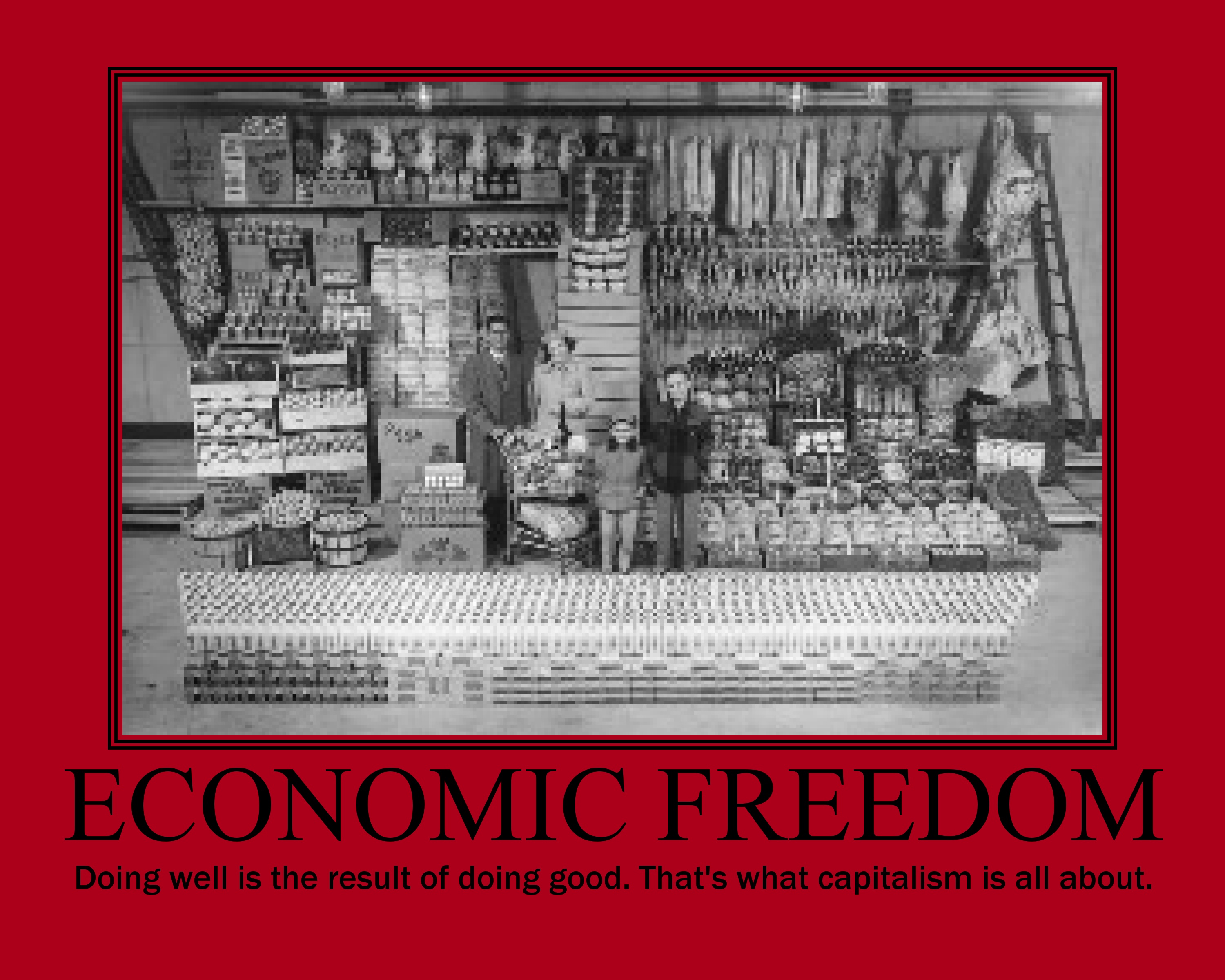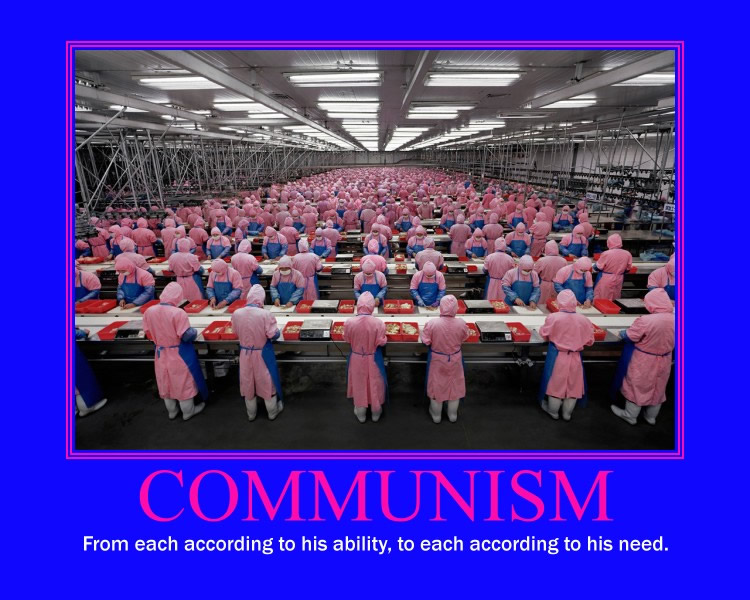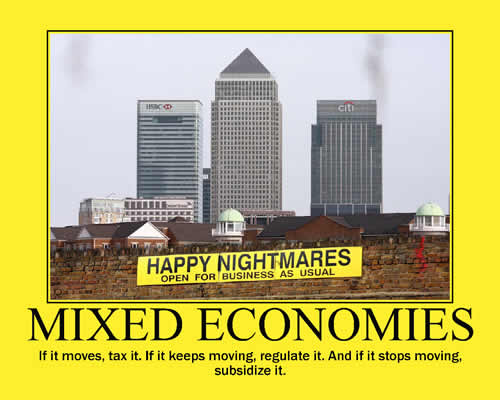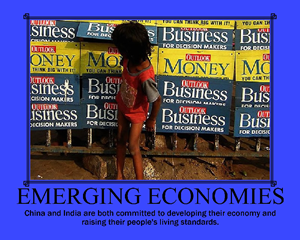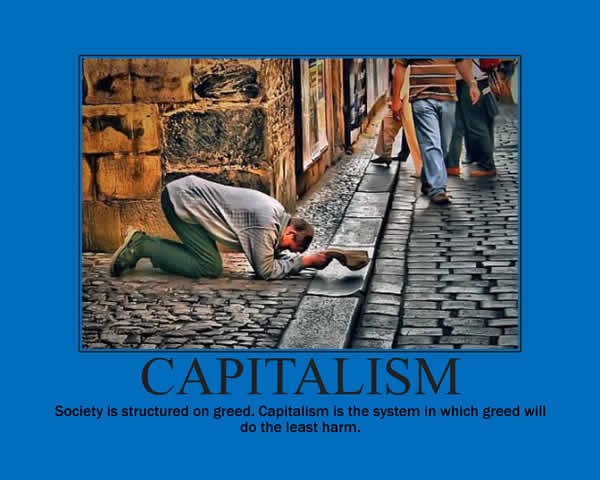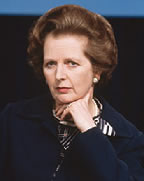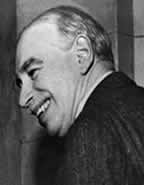UNIT 6: ECONOMIC SYSTEMS AND LIBERALISM TODAY
| Site: | MoodleHUB.ca 🍁 |
| Course: | Social 30-1 RVS |
| Book: | UNIT 6: ECONOMIC SYSTEMS AND LIBERALISM TODAY |
| Printed by: | Guest user |
| Date: | Monday, 3 November 2025, 6:36 AM |
Table of contents
- 1. OVERVIEW
- 2. UNIT 6 CONCEPTS AND TERMS
- 3. Economic Systems Review
- 4. Traditional Economies
- 5. Command Economies
- 6. Mixed Economies
- 7. Emerging Global Economies
- 8. Modern Economic Challenges
- 9. Neoconservative Responses
- 10. QUIZ 6.1: ECONOMIC SYSTEMS 2: THE SECOND ONE
- 11. Consquences of Economic Freedom
- 12. Determining Economic Equality
- 13. Equality of Care
- 14. Sustainable Economic Development
- 15. UNIT 6 SUMMARY
- 16. SUMMATIVE EXAM 3: UNITS 5 & 6
1. OVERVIEW
Adam Smith believed that if everyone worked in his or her self-interest with few controls or regulations over the economy, we would all prosper. In fact, economic freedom, self-interest, competition, and the ownership of private property are some of the essential principles of liberalism. The differences between liberal and collectivist nations are often seen most clearly in their economic systems.
After World War II, Adam Smith's ideas seemed to be correct. Free from the fear of war and connected by technology, most of the world's liberal democracies experienced an era of unprecedented economic growth. Wages for the average worker grew and societies prospered.
The 1951 photo published in the U.S. publication Life Magazine, shows the Czekalinski family of Cleveland, Ohio, surrounded by all the food a typical family ate in a year-purchased on an average hourly wage of a worker of less than two dollars an hour.
End of World War II
At the end of World War II, many people believed that the economic freedom of capitalism would lead to wealth for anyone who was willing to put in an honest day's labour. On the other hand, the Soviet Union and its command economy promoted greater government ownership and control. When communism in the former Soviet Union collapsed at the end of the 1980s, it seemed as if the way to success for the majority of people was economic freedom.
Flash forward to 2010. Although millions of people in North America have reaped the rewards of a capitalist economy, the disastrous downturn in the economy left thousands homeless and unemployed. Meanwhile, communist China has an economy that continues to grow rapidly. Much of the world now buys products Made in China.
As well, environmental degradation, caused by consumerism and unchecked economic growth, has led many people to question an unregulated economy. What happened? Is laissez-faire capitalism doomed to fail? Are there other economic systems that serve people better?
You will finish the unit with a better sense of economic systems around the world today and how well they represent liberal principles through an investigation of the following issue:
This unit has two sections:
- Types of Economic Systems
- Contemporary Challenges for Economic Systems
2. UNIT 6 CONCEPTS AND TERMS
Unit Question: To what extent should economic systems reflect the principles of liberalism?
Issue Question: To what extent are the principles of liberalism viable?
In this unit, you will explore the following questions arising from the issue question:
- How are liberal principles reflected in the world's economic systems?
- Which is more important: economic freedom or economic equality?
- Do economic systems need regulation?
This is a list of new terms you will encounter in this unit.
capitalism
command economy
democratic socialism
demand-side economics
division of labour
economic equality
economic intervention
economic system
fiscal policy
market socialism
mixed economy
monetarism
nationalization
neo-conservatism
perestroika
private property
privatization
progressive taxation
Reaganomics
regulation
shock therapy
supply-side economics
sustainable development
stagflation
traditional economy
trickle-down theory
People Make History!
3. Economic Systems Review
What is an economic system?
Why do we need one? Economics is often called the "science of scarcity" because the world does not have unlimited resources yet we place almost limitless demands on the resources that exist. An economic system is the way a society organizes the production, distribution, and consumption of goods and services. Who gets to make the stuff we use? Who gets to buy it? Are there rules for making, buying, and selling the things we need and want? If there are rules, who makes them?Just as political systems, our economic systems are based on ideologies-ideas about how the world should be, which are based on beliefs and values. Economic systems can be based on individualism or collectivism. They can be based on the idea that the individual is of the utmost importance and personal freedoms should guide the way societies manage their resources, or they can be based on the idea that the community and its collective interest is most important.

|
Capitalism is the dominant economic system in the world today based on individualism including the principles of individual rights, working in self-interest, and owning private property with a very limited role for government. Communism is based on the principles of collectivism, including economic equality and public property with a strong role for the government.
However, capitalism and communism are ideas. In reality, almost all economic systems are somewhere along the left-right continuum as indicated by the graphic shown below and inside the back cover of your text book.
For example, the United States is a capitalist system, yet the government makes rules to protect the environment and to offer certain public services such as public education. A communist country such as China allows individuals to own property and buy and sell goods and services for a profit. Even during Soviet rule in the former USSR, people were allowed to own private property.
The diagram demonstrates the role of government in the economy. Economic systems on the right exhibit more freedom for the market while those on the left exhibit more reliance on government to manage economic affairs.
In an economic system based on collective interest and responsibility, the government has a greater role in providing regulations for businesses, establishing higher rates of taxation, and providing more government-funded services to benefit society. Government spending ranges from building and maintaining roads, to providing health care, child care, pensions, and education, to offering incentives for small business. In an economic system based on individual rights and freedoms, individuals and corporations have larger roles. Businesses are less regulated, consumers and the environment are are less protected, and rates of taxation are lower and, correspondingly, fewer dollars are spent on programs to benefit all society.

4. Traditional Economies
 Creative Commons
Creative CommonsIn many Aboriginal societies, wealth has a different meaning than it does to people in the industrialized world. Wealth in traditional economies is based on history, tradition, connection with the land, and interactions among people.
Traditional economies around the world are disappearing.
This type of economy ensures that every member of society has a purpose within society. It is less demanding on the earth's resources because goods are manufactured by hand and there is no incentive to overproduce as in other economic systems.
5. Command Economies
You learned that one of the reasons for the collapse of the Soviet Union was the failure of its economy. Central planning failed to provide the people of the Soviet Union with economic freedom. Their needs were not met through central planning.
The photo by Canadian photographer Edward Burtynsky is of a modern-day chicken processing factory in Communist China.
In recent years, China has taken a very different economic approach in its communist economy, leading to astounding economic growth. You will learn more about China in the next section.
Is a centrally-planned economy necessarily destined to fail?
- What are the characteristics of a command economy?
How much freedom is there in a command economy?
Your study of the economic system of the former Soviet Union showed you that people had very little economic freedom. Business owners could not compete with one another for economic success. There was very little opportunity for people to work in their self-interest. Individuals could not get rich by having a great idea and building a product to sell. Consumers had little choice in the products they could buy. Individuals were not always free to choose their own career paths.Central Planning
In the USSR, the State Planning Commission (GOSPLAN) produced "Control Figures" or forecasts for the economy in the early years of communist rule. They made plans and suggestions to increase production in state enterprise. After 1927, Stalin demanded more ambitious plans and the first of many "five-year plans" was presented. The first Five-Year Plan concentrated on the development of iron and steel, machine-tools, electric power, and transport to produce machinery to improve agricultural production. There were 12 Five-Year Plans during communist rule in the Soviet Union. All enterprises were required by law to fulfill their targets.
Cooperation
The communist goal of working towards the collective interest was also encouraged in the production of goods. To meet production quotas, factories often engaged in the practice of "storming" or racing to meet goals in the last week of the month, causing accidents and producing poor goods. Soviets learned not to buy goods made in the last week of the month. Workers who did not cooperate were imprisoned, and those who tried to organize strikes were arrested for "anti-Soviet" activity. Factory managers often covered their failures by reporting the output of their factories inaccurately to avoid being fired.
Incentives
Initially, higher wages, better housing, and public recognition were used as incentives to meet and exceed production quotas. Those who performed most impressively were called "heroes of labour" and became national celebrities. This campaign ended in the mid-fifties and was replaced with more tangible rewards such as vacations, cash bonuses, and imported goods. Trade unions, unlike in capitalist economic systems, did not act to protect the worker; instead, they ensured members met targets and punished unsatisfactory workers.
Property Ownership
As the poster below notes, communism calls for the the abolition of private property. Did that mean that no one in a communist economic system can own anything? Not at all. Although capital in a communist system was government-owned, individual people could still own things including agricultural plots of land and their own homes. What could not be owned were the land, labour, and capital that could be used to produce greater personal wealth. The idea that one human being could not use the labour of another human being (sometimes called "human capital") is a key difference between capitalism and communism. In the early days of communism, natural resources, heavy industry, and banking were nationalized. In other words, the government took over these important industries from private owners. The government was able to use its power and control to modernize industry rapidly through state ownership and planning. This wealth was used initially to enrich the nation through social programs and greater employment. In the early years of the command economy, there was rapid economic growth, but in later years poor planning, bureaucracy, and the resulting inefficiency led to decreasing effectiveness.
Collectivization of Agriculture
Under Stalin, a plan to nationalize agriculture was put into action with less successful results. Reflect on the translation of a Soviet poster created in Stalinist Russia. Does it suggest any that any of the principles of liberalism should be followed? Does it suggest principles of collectivism?
Soviet Poster
|
Watch this lecture on the difference between command and free market economies.
- To what extent does a command economy meet the needs of its people?
- Why did a command economy in the Soviet Union fail?
- How did Perestroika and Glasnost attempt to liberalize the Soviet Union?
Perestroika and Glasnost
Beyond Perestroika
Although the Soviet Union and China both used command economies to redistribute wealth and to modernize industry in their countries, by the 1980s there were many signs that the command economy was not working. Government ownership led to a lack of
incentive for workers to produce the best product possible. The citizens of these nations wanted greater freedoms both politically and economically, and they participated in demonstrations to make their voices heard. They took very different routes
to achieve change, one resulting in the collapse of the formerly powerful communist nation and economic hardship for its citizens, and the other leading to continued communist control and ongoing economic success.
Soviet Restructuring
Under Soviet President Mikhail Gorbachev, the process of perestroika, or reform, began. Economically, Gorbachev initiated laws to allow private ownership of industry and foreign investment. His first reforms looked at majority Soviet ownership and control of foreign investment, but this soon changed to allow foreign firms to own and control Soviet business. By 1991, the communist party had lost control of not only the economy, but the support of the people. The Soviet Union collapsed and its member states left the union to form their own governments.The American political cartoon by a former resident of the USSR shows Marx, Stalin, and Lenin looking down in amazement from their communist version of heaven on the death of communism with its funeral parade led by President Gorbachev.
|
6. Mixed Economies
Does a mixed economy provide a happy alternative, with the potential to allow enough freedom to provide incentives for hard work and new ideas while at the same time providing the positive freedoms and security to benefit the majority?
The photo was taken by a British researcher shortly after the global economic crisis began. In the background are the skyscrapers owned and operated by international banks. In the foreground, the banner reads "Happy Nightmares: Open for Business as Usual."
What do you think the banner refers to? Does it suggest that an unregulated economy can lead to a nightmare for people's employment and their savings? Or does it suggest that the real nightmare is when governments bail out failing business enterprises?
The quotation on the poster comments on the attitude of some governments toward the economy. This quotation is from former US President Ronald Reagan who believed in smaller government and fewer rules. In this context, it has a message that governments tend to interfere too much in the economic affairs of their people.
A mixed economy is an economy based on the principles of private property and economic freedom, but also it includes public property and some limits or regulations to benefit collective interest. Ideologically, it has aspects of both collectivism and individualism.
|
Canada and Sweden
These two countries are examples of nations that have developed mixed economies based on their values and principles. When we think about mixed economies, we tend to think of democratic nations that operate their economies on free-market principles but with greater regulation of industry and some degree of public ownership. Another term for this system is democratic socialism. A key belief behind mixed economies is that the government has some responsibility for the common good. Voters elect governments that value individual rights, including the positive right to freedom from excessive poverty. They also value a degree of equality that include social programs to protect their citizens. A key reason Canadians have not been effected as negatively by the global economic downturn was regulation of the banking sector. Canadian financial institutions have clear rules that control how money can be lent and borrowed. These rules protect investors and consumers. (See " Rights and Freedoms in Mixed Economies".)In Canada, most health care services and education programs are publicly owned and operated. Hospitals and schools are operated by provincial governments, and healthcare and education are free to all Canadians. The government of Canada also operates several crown corporations, which are businesses that serve the needs of Canadians. These are often businesses that the private sector was not willing to provide to all citizens, or businesses that promote Canadian culture. The CBC and Canada Post are examples of crown corporations.
|
Perspectives on Social Programs
Supporters of the free market, especially neo-conservatives in the United States, often criticize the social programs provided by mixed economies because of their ideological perspectives. They believe so strongly in individualism that they feel people should be self-reliant and should not depend on outside forces to help them in times of trouble. They also feel that, if everyone was self-sufficient, there would be little or no need for income or corporate taxation, leaving more money in the hands of individuals.If you watch Fox News or other conservative television networks, you may hear taxpayer-funded programs such as healthcare called "liberal" or "socialist" and nations that provide them called "welfare states". Keep in mind that these terms are meant as criticism. When used in this way, they show that people around the world have very different understandings of what these words mean. For most Canadians, Europeans, and citizens of other liberal democracies, these terms do not carry such a negative connotation.
|
|
Is a mixed economy primarily collectivist or primarily individualist in its ideological approach?
To what extent is a mixed economy viable today?
7. Emerging Global Economies
Canada and Sweden are both industrialized nations. Their economies have been strong for decades, and although not everyone in these two countries is rich, the standard of living is high and people have many opportunities to prosper.
But what about the poor nations of the world? What economic system is best suited to raise them out of poverty? Economists call nations such as India and China "emerging economies". Their economic power has yet to reach its potential. With huge populations and strong education systems, the two nations are showing that formerly poor nations can rise up with the help of both economic freedom and government intervention.
The quotation on the poster is from former Chinese premier Li Peng who called for the reform of the Chinese economy. The image is from an Indian author and activist, Rita Banerji, who has established a movement to oppose the genocide of Indian girls. Li Peng saw capitalism as the way forward for the Chinese, while Ms Banerji's photo demonstrates powerfully that capitalism in India has not led to economic success for all sectors of society.
China's Economic Approach
As a communist nation, China took a very different approach than the Soviet Union in reforming its economic system. The nation knew that it was not keeping up with other, more industrialized nations, but it could
not afford to modernize. Millions of people lived in abject poverty. Under Deng Xiaoping, reform began at the bottom and worked its way up. Called "Socialism with Chinese characteristics" these reforms began in 1978 and moved China from being a poor
agricultural nation to the world's fastest growing economy over the next 30 years. 53% of the people of China lived in poverty in 1978, while by 2001 only 6% were in that situation. Another name for this type of economic system is market socialism.
The change from command economy to a more market-oriented economy was gradual and occurred in small steps. Individual farmers were permitted to produce and sell their products on a small scale; this led to an immediate increase in production and a reduction in poverty. Townships and municipalities were allowed to set up their own industrial operations. Special Economic Zones were established in which foreign investment was permitted.
This 1960s American cartoon was drawn long before China moved away from its agrarian roots to begin economic rebuilding. It shows former Chinese leader Mao Zedong standing in front of a group of starving people who face coffins reading "Victims of Hunger in Red China." The caption reads "By Government Decree Every Member of the Commune is Entitled to a Private Plot." It uses irony to show the only private property a communist Chinese person could expect to own was his own grave.
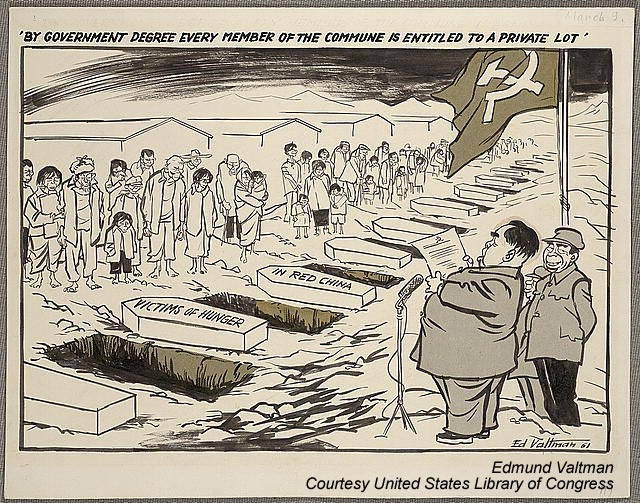
India's Economy
Unlike China, India is a democracy. A huge and highly populated country, India is made up of many religious and ethnic groups. India was a colony of Great Britain until 1947. During British rule, railway networks, schools,
and a system of governance characterized by bureaucratic regulations were established. After it regained its sovereignty until the early 1990s, it practised democratic socialism with high levels of protectionism, public ownership, and continued economic
regulation. Its economy grew slowly, and millions lived in extreme poverty. Since then, its economy has moved towards greater reliance on the market and is now the second-fastest growing economy in the world. India has made huge gains in providing
all children with education, and it has made the right to an education fundamental in its constitution.
However, per capita income in India is 119th in the world, according to the International Monetary Fund. Those who live and work on farms (over half the population) are still mostly very poor and uneducated. Millions have moved to urban centres, hoping to improve their lives but often without success. Child labour continues to be a problem. In many parts of India, women still do not have equal rights to men. Cultural norms value boys over girls: female fetuses are often aborted, and female infanticide is a major issue.
Emerging Economies and Equality of Opportunity
Although both India and China are experiencing phenomenal economic growth, success is experienced by the educated middle and upper classes. Those people who work in the fields, as most Chinese and Indian people do, are being left behind. In 2015, 24% of people living in poverty lived in India. (Source: World Bank) Economic success has also led to environmental degradation.- How similar are the economic systems of China and India, considering their political systems are very different?
- To what extent has economic liberalism led to benefits for the average citizen in China and India, and to what extent has it led to further problems?
- To what extent do these emerging global economies threaten the economic systems of the developed world?
8. Modern Economic Challenges
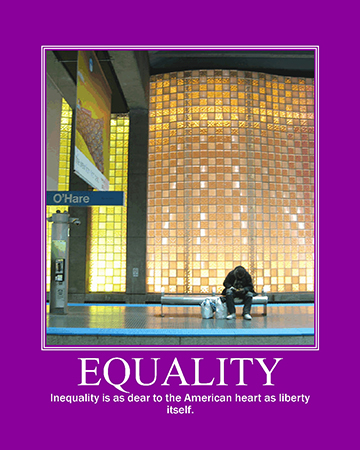
There are opportunities and challenges that accompany any political and economic system. Liberalism, with its focus on individual freedoms, has had unexpected and undesired consequences.
This image from Japanese flickr photographer Hani, is of a homeless man sitting at a subway stop in Chicago. His poverty contrasts starkly with his colourful surroundings.The quotation by American journalist and author William Dean Howells points out the irony of American life. In a nation whose founding document begins, "We hold these truths to be self-evident, that all men are created equal..." and whose "American dream" is based on the idea that freedom holds the promise of prosperity, the reality is great disparity between rich and poor. In fact, in the United States, the gap between rich and poor is one of the highest in any wealthy nation and, according to its own records, has been steadily increasing since the early 1980s.
Income inequality in wealthy liberal democracies can be seen not only between a handful of rich people who own most the wealth and the majority of households who own far less, but also between men and women, between people of different racial backgrounds, and between the educated and the uneducated.
Inequality among nations is also a problem for a world that is following liberal principles increasingly. Although industrialized nations are wealthy, almost half the world-over three billion people-live on less than $2.50 a day.
In addition to inequality, environmental issues are concerns the world over. Decreasing natural resources, food shortages, poor air quality, and climate change are issues that face everyone in the world, regardless of their ideology. Will the unlimited economic growth limit the potential of future generations? How much are the principles of liberalism to blame for economic deregulation? Are limits to our freedoms necessary to preserve the world?
The contemporary world is faced with many challenges. As citizens in a democracy, we can decide what steps must be taken to deal effectively with those challenges. Will we continue to allow unregulated growth with the belief that the market will take care of itself? Or will we choose to put limits to liberalism?
9. Neoconservative Responses
An economic system that is fully liberal has few rules or controls beyond the rule of law. People are free to act in their own interest with complete freedom to compete for wealth. In a laissez-faire or free market (capitalist) economy, corporations have the freedom to expand as much as they are able to, driving smaller and less efficient businesses out of the marketplace. Those with skills, talents, drive, and access to capital can accumulate more and more property while those who are lacking those qualities will not.
The Free Market and the Common Good
The trickle down theory is the capitalist notion that when successful individuals accumulate a great deal of wealth, it trickles down to those with less money. For example, an extremely wealthy person like Bill Gates will invest his money in
business operations that hire others. He may pay his employees more because he has more to spend. He will buy clothing and houses and cars and eat in restaurants and the money he pays for these goods and services will go to others. According to this
view, those with great wealth should not be taxed heavily because it would punish not only those who generate wealth but also the people they employ.
Supply-side economics is another term used to describe an economic system that focuses on the supply of goods and services to consumers in the belief that economic growth can be most effectively created by lowering barriers for people to produce (supply) goods and services, including lower income tax and capital gains tax and reducing regulations. In turn this will benefit consumers by providing a greater supply of goods and services at a lower price.
What does the cartoon suggest to you? It was created in response to the global financial crisis that began in 2007. Read more...
Adam Smith believed that the economy was guided by an invisible hand. Other economists believe there is some sort of natural law that controls economic systems and the government should not interfere with this natural process. If there are "natural laws" that control the economy, they indicate that the natural result of capitalism is a boom and bust cycle that can have disastrous effects.
Most of the world's governments, whether they are in liberal democracies or not, intervene in their economies to some extent for the good of the people in their nations. Should they? Economists who are strongly in favour of economic liberalism say "no."
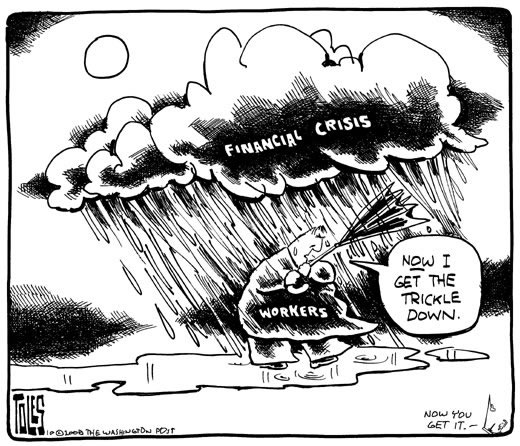
There are many perspectives on what role the government should take in an economic system. In Unit Three you learned about Keynesian economics. Keynes suggested that a government should intervene in the economy in times of crisis to help alleviate the effects of the boom and bust cycle and the success of the New Deal was the result.
Economists such as Milton Friedman and F A Hayek have suggested that there should be few rules governing economic systems. Political leaders such as Ronald Reagan in the United States, and Margaret Thatcher in Great Britain followed their advice, cutting government spending, decreasing taxes, and turning publicly managed enterprises over to the private sector.
- What is monetarism?
- How is supply side economics different than demand side economics promoted by John Maynard Keynes?
- How could neoconservativism be considered a return to classical liberal economics?
For biographical information about each of these influential economists and politicians, see the links.
- Explain how Thatcherism and Reaganomics reflected a neoconservative approach to the economy?
- To what extent are the ideas of Friedman, Hayek, Reagan and Thatcher viable today?
Supporters of the free market believe that economic freedom means the freedom to succeed and the freedom to fail. Yet in 2008 the government of the United States-the nation that most strongly reflects the principles of economic liberalism- bailed out failing corporations with over 700 billion dollars of taxpayer money. Governments also provided subsidies and tax incentives to large corporations to keep them in operation. This is sometimes referred to as "corporate welfare," a way to keep corporations on their feet in troubled times.
Globalization has shown that on a worldwide scale, a free market economy may lead to economic success for some and disaster for others. As huge corporations outsource the manufacture of their goods to countries where labour is the cheapest, they provide economic opportunities to people in the developing world while leaving workers in the developed world with skills they cannot sell. The globalization of wealth means that people can speculate on the value not only of stocks but of international currencies, with the potential to devastate entire nations.
Computer programmes that trigger the buying and selling of stocks based on an automated response can cause huge fluctuations on the international finance, with the potential to bankrupt individual and corporations at a moment's notice. Freedom in the banking sector has allowed banks to loan money to whoever they want, driving people and nations into debt.Today, even though there are conflicting perspectives on government ownership of property and government intervention in the economy, almost every nation regulates its economy to some extent for the common good.
10. QUIZ 6.1: ECONOMIC SYSTEMS 2: THE SECOND ONE
- Go to the unit tab
- Go to the 6.1 quiz.
- Do the quiz
- Be happy you finished a quiz
11. Consquences of Economic Freedom

For example, in 2000, the people of Bolivia rioted, creating a national state of emergency when their water supply was privatized. At the insistence of the World Bank, control of their water supply was sold to international corporations.
Household water costs increased to $20 per month in homes where the average income was only $70.
Does economic freedom affect us all equally? Think about what you learned in Social Studies 10-1 about the legacies of imperialism. You may recall that Europeans settled in North America and established mercantile colonies in Africa, Asia, and South and Central America. They settled the land, removing Aboriginal people from their homelands. They extracted resources and encouraged local farmers to produce cash crops such as cocoa and coffee instead of food products that they could feed to their own families. The profits from these ventures went to the world's first multinational corporations, such as the Dutch East India Company-and to the governments of the colonizing nations.
These injustices have led to long-term issues worldwide.
Corporations are certainly not evil. They employ workers and provide profits to shareholders. They produce goods and services used by people in all walks of life. In fact, most people work for corporations and benefit from the purchase of their products and services. If we in liberal democracies truly value economic freedom, then corporations have the freedom to grow and expand. With money comes power.- List some of the unanticipated consequences of promoting economic liberalism.
- What particular aspects of liberalism helped create these unanticipated outcomes?
12. Determining Economic Equality
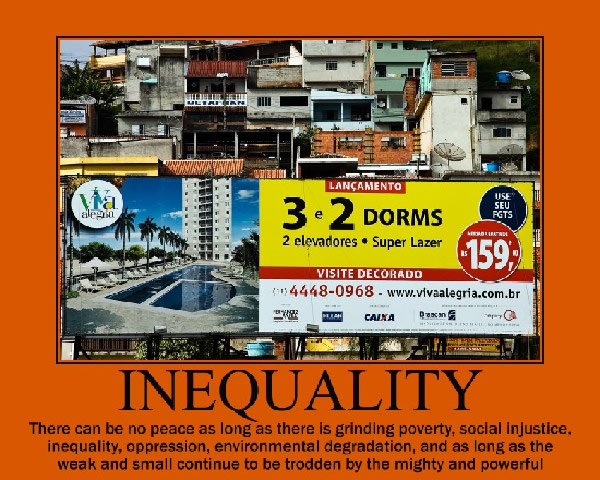
What is "equality"?
- The United Nations Universal Declaration of Human Rights says "All human beings are born free and equal..."
- The Canadian Charter of Rights and Freedoms says "Every individual is equal ..."
- France's Declaration of the Rights of Man says "Men are born and remain free and equal..."
- The U.S. Declaration of Independence says "We hold these Truths to be self-evident, that all Men are created equal, that they are endowed by their Creator with certain unalienable Rights, that among these are Life, Liberty, and the pursuit of Happiness..."
Reality shows us that although it may be a common belief that people are equal, they certainly are not born with the same skills and abilities that will help them prosper equally. People are not all born into homes or communities where they have all the same advantages and opportunities.
Political systems in liberal democracies today clearly outline equal voting rights for all adult citizens. This reflects modern liberal values. Every person has the right to take part in an election. Human rights are clearly defined in law and protected in practice in almost every nation of the world. But what about economic equality? Is it protected? Should it be?

Economic systems in liberal nations are designed to give people equality of opportunity, which reflects classical liberalism. Under Adam's Smiths ideas about the invisible hand, the economic freedom of the free market should help everyone get ahead. Does it work? History has shown that while everyone may be born in a society that believes anyone can succeed, the reality is much different. Modern liberal democracies implemented laws that reflected equality of outcome or equal treatment. As a result, many of these same nations also adopted some collectivist values, which includes economic equality.
Let's take a look at the United States. The "American Dream" is that those who work hard will prosper. According to the Pew Economic Mobility Project, from the end of World War II until the mid 1970s, the average American family's income doubled. From 1973 until 2007, it grew by 22%- and with two incomes per household, rather than the one income that had been the norm in the past.
In 2004 men in their 30s actually earned 12% LESS than their fathers had done at the same age. By 2008, the typical family had a lower income than it did in 2000. The gap between rich and poor continues to increase. A Brookings Institute study shows that the key factors behind income equality are family background, education level, and having a mother who received her education and married before having children.
Income inequality is measured by something called the Gini Co-efficient. The Gini co-efficient is a mathematical way to calculate anything with a distribution, although it is usually used to measure the distribution of wealth. The lower the number, the closer people are to having the same income.
The map shows you that people in Canada and Europe have incomes that are closer to one another, while in the United States there is a larger gap between rich and poor.
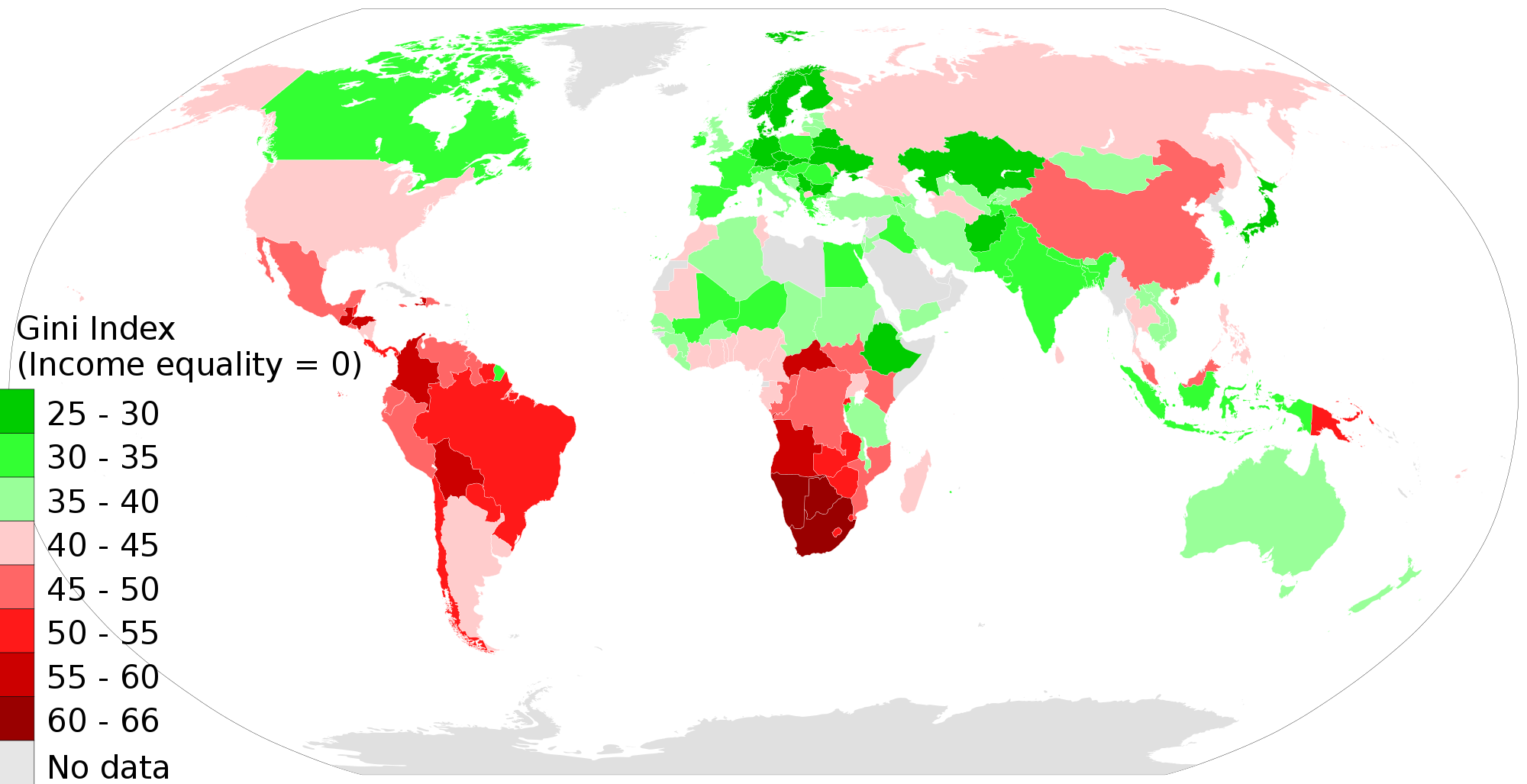
On this chart, income equality is shown in green, moving to red for the most unequal distribution. The most extreme level of inequality is shown in dark red.

This graphic shows that different economic systems use different methods of achieving income equality for the common good.
The government of Canada uses progressive taxation, so that those who earn more money pay a higher percent in income tax. In 2019, federal income tax in Canada was 15% on the first $47,630 of taxable income ranging up to 33% of taxable income over $210,371.
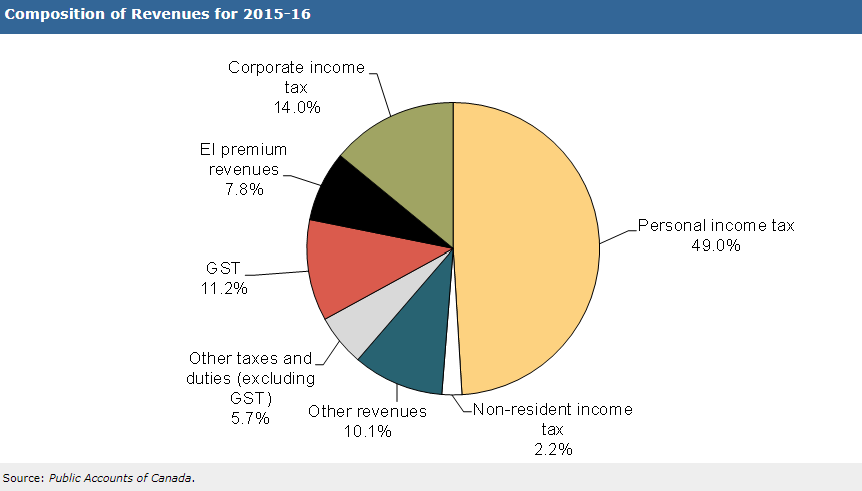
In addition, each province and territory in Canada has income tax for its residents. In Alberta, residents pay 10% for the first $131,220, and those who earn more are expected to pay anywhere from 12% to 15% of their income in taxes. Albertans who make more than $314,928 a year will be taxed 15%. In BC, residents pay 5.06% on the first $40,707 of taxable income, up to 16.8% on the amount over $153,900.
Many provinces, states and nations also impose a variety of consumption or "value added" taxes in the form of sales tax. In Canada, the GST or Goods and Services Tax is 5%.
Thus, the Canadian taxpayer most definitely supports financially the programs of the Canadian government. In the European Union, the VAT (Value Added Tax) is 15%. In the United States, each state has its own sales tax ranging from 0-13%.
|
13. Equality of Care
Canadians value universal healthcare, sometimes referred to as "medicare" or "socialized medicine" (as it is called in the US). It is a Canadian taxpayer-funded and provincially-managed program that provides quality care to all Canadians regardless of their ability to pay. However, private healthcare is not an option for Canadians. Those who want more immediate service, private rooms, or certain types of treatment must leave the country to get it. The decision to provide universal health care was made by Canadian members of parliament, supported by voters.
In the United States, people must purchase private insurance, pay their own medical bills, or belong to a Health Maintenance Organization. Sometimes referred to as "managed care", an HMO is a group of hospitals, doctors, and other providers contracted to provide a level of service to subscribers. In 2010, 15% of all Americans had no health care insurance, and 35% did not have enough insurance to cover their medical needs.
Is private health care better than public health care?
This issue has been in the news for some time, especially in the United States where politicians on the right of the economic spectrum and medical and pharmaceutical lobbyists work to persuade voters that Canadian style health care is inferior and deprives them of the fundamental freedom to choose their own form of health care. About 91% of Canadians say they prefer the Canadian system of health care to that in the United States, and 70% say it is working well or very well for the nation, as compared to only 25% of Americans who believe in their own health care system.
Consider an example of coronary by-pass surgery. Canadians requiring a heart by-pass do not pay for it. The cost is paid through their healthcare dollars. In 2005, the average cost to the healthcare system of by-pass surgery was $10 000. In the United States, individuals or their private health insurance providers paid on average $20 000 for a by-pass. Canadians stayed in hospital nearly 17% longer. There was no difference in mortality rate.

©Bruce MacKinnon: MAC1509, Artizans
Study this cartoon.
What are the artist's concerns regarding possible privatization of health care in Canada?Consider the two world maps. The one shows land mass; the other map distorts the nations of the world to represent how much is spent on health care.
Which nations seem to spend an unusually large amount on health care? Which nations pay far less?
In fact, the United States spends more money on health care per person than any nation in the world. Studies estimate that 62% of all bankruptcies in the United States are caused by medical bills.
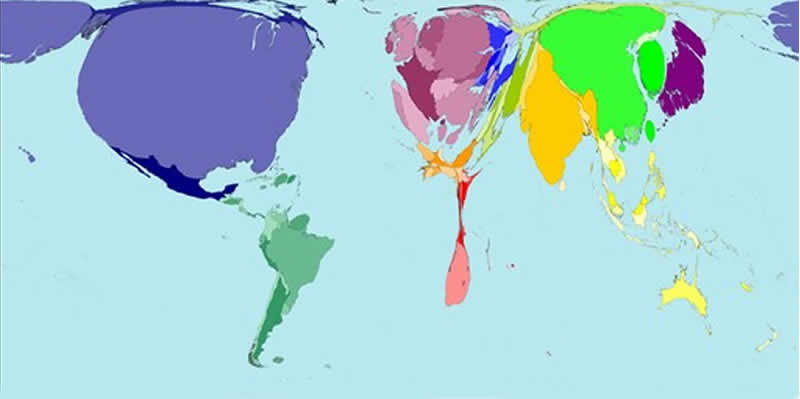
Distorted land mass
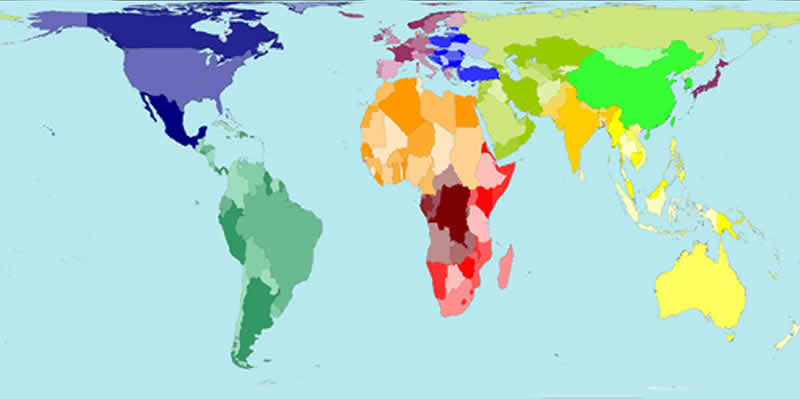
Land mass
- Is the right to healthcare a fundamental human right?
- Is the right to choose your own level of care more important?
- Should the right to the economic freedom provided under privately-run healthcare take precedence over the common good?
- His perspective favours a Canadian type of system. The thought-provoking 1997 comedy/drama Critical Care looks at the effects of the American medical system. Warning: Movie is rated for mature audiences due to language.
14. Sustainable Economic Development
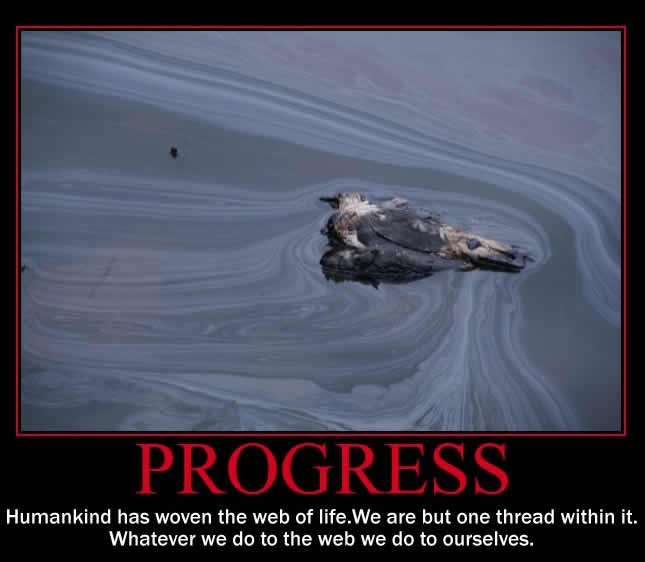
"Hundreds of Ducks Die in Oilsands Tailings Pond"
Read the headlines in Alberta newspapers in April 2008.Although government regulations require the ponds to have measures to keep migrating waterfowl from landing, these devices were not in working order, leading to the deaths of the ducks.
Environmentalists were outraged by this catastrophe, and the disaster illustrates negative effects that may result from economic liberalism.
Quotation from Chief Seattle
Liberalism is based on a belief that owning private property and working in self-interest are good. Liberal economic policies call for economic freedom and little regulation for industry. Unlimited freedom to consume goods coupled with limited regulations on industry may lead to occurrences such as the tailings pond disaster.
Other examples of environmental destruction surround us. Can humankind's impact on the environment be ignored if we want the planet to survive and sustain future generations of life-including ducks and humans?
The quotation on the poster by First Nations leader Chief Seattle provides an Aboriginal perspective on the environment. It reflects the idea that all of life is interconnected. Environmental degradation affects everyone.
- Is it surprising that consumerism is a necessary outcome of liberalism?
- Must consumerism lead to environmental destruction?
- Or can the freedoms of liberalism ensure the will of the people in regard to the environment is considered?
Consumerism leads to an increasing demand for new and better products. It leads to a society that values economic growth. Worldwide, economic growth has had a profound effect on the environment. Syncrude Canada produces oil in response to a global demand by consumers. How much are they to blame for the destruction of the environment when they are creating a product that is in demand-at the lowest possible cost-by people around the world?
Many citizens have demanded that the environment be protected through government regulation.
- What is the impact of economic growth on the environment?
- How does the Canadian government's response to environmental concerns reflect modern liberalism?
- To what extent do the policies of the Alberta government reflect the desire to balance economic freedom with sustainable development?
- An Inconvenient Truth
- The End of Suburbia
- Food, Inc.
- Flow: For Love of Water
15. UNIT 6 SUMMARY
Unit Six has explored:
- various forms of democracy including the systems of Canada and the United States
- the various economic systems that exist in the world today and that have existed in the past
Traditional economic systems of the past involved total freedom for producers and consumers, laissez-faire capitalism called for complete individual freedom and competition, and the command economies of most capitalist nations call for much central planning and government control. In today's global economy, unregulated capitalism has led to several problems including the immediate movement of wealth between nations, economic disparity, and global financial crises. To combat these issues and ensure that economic systems work for the maximum benefit, most nations incorporate a degree of economic freedom with a degree of regulation. Your study of economic systems and contemporary issues should help you understand the extent to which liberal values are workable in the economies of our interconnected world today.
Through this study, you should now be closer to having your own ideas about whether liberalism really works, and if in democratic nations economic freedom and economic equality can co-exist.
| Challenges for Liberal Democracies | Economic Systems |
|
|
Contemporary Challenges for Economic Systems
What happens when the individual freedoms of individuals interfere with the needs of the group? Many nations and global organizations have developed policies and practices to ensure that human rights are protected. In the final unit that addresses the challenges of liberalism, you will look at individual and collective rights.
When you have finished reviewing your notes, complete the Unit Review for Unit Six. When you have completed the multiple choice review, take a look at the feedback provided. If you so choose, after waiting 30 minutes, you may complete
the quiz again, keeping in mind that the questions and the order of the possible answers are randomly generated. The second version of the review will be different from the first. Your grade will be the average of both graded attempts.
16. SUMMATIVE EXAM 3: UNITS 5 & 6
Please review all of your notes, readings, and vocabulary you have
learned up until this point. Once you feel you are ready, you can
attempt your third summative exam of the course. You will need
permission to write this exam and you will need to be supervised at your
school or campus.
Please let me know if you have any questions!
